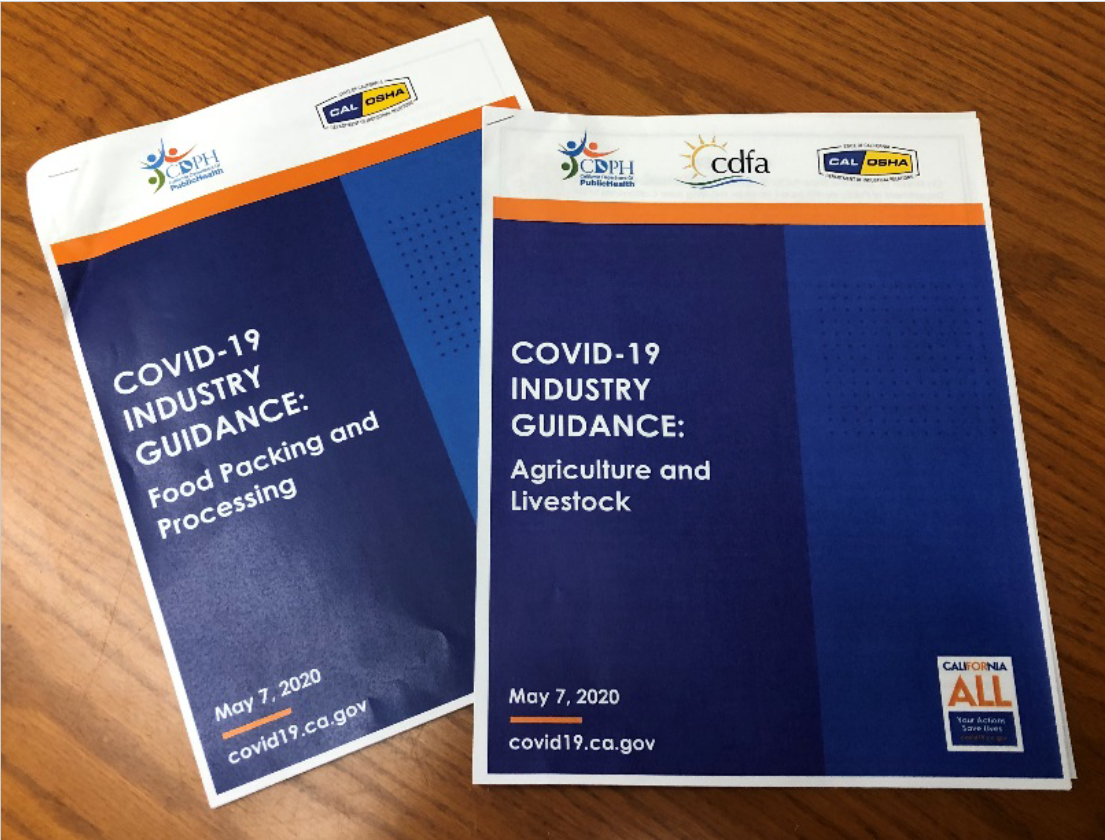COVID-19 has been devastating. More than 100,000 lives in the United States have been lost and the State of California’s budget has plummeted to more than $54 billion in debt. And in early May, unemployment claims in California exceeded 4 million! But through it all, agriculture in California continued. It continued because it had to.
According to the California Department of Food and Agriculture (CDFA), California produces about one-third of the nation’s vegetables and approximately two-thirds of fruits and nuts. Recognizing the obvious importance of agriculture, Federal and State governments designated agricultural operations as essential businesses and the workers at those operations as essential employees. With that declaration comes a responsibility to protect these workers against the spread of COVID-19 in the workplace.
Recently, Cal/OSHA released new guidance and checklists for Agriculture and Livestock, and for Food Packing and Processing. This new guidance is intended to support a safe, clean environment for workers in these areas. The update now mandates a “written worksite specific plan” for these operations to protect workers. Included in the guidance is information on what is required in the written plan, training topics, individual control measures, cleaning and disinfecting protocols, and physical distancing guidelines. As I write this article, it is only guidance: however, there is legislation (AB 2043 by Assemblyman Robert Rivas) that would mandate agricultural employers (and only agricultural employers!) take this “guidance” from Cal/OSHA and mandate that it be implemented and for it to be considered a “crime” if not carried out. On top of that, a petition by “Worksafe” was filed recently with the Cal/OSHA Standard Board to require written plans and protections for all workers potentially exposed to COVID-19.
With all that said, there most likely will be some type of mandate to implement a written plan and protections for workers from COVID-19.
To view the actual guidance documents and inspection checklists for farms and food packing or processing facilities, please go to the State of California’s dedicated COVID-19 website at http://covid19.ca.gov/industry-guidance and view the following documents:
- COVID-19 Industry Guidance: Agriculture and Livestock
- Cal/OSHA COVID-19 General Checklist for Agriculture and Livestock Employers
- COVID-19 Industry Guidance: Food Packing and Processing
- Cal/OSHA COVID-19 General Checklist for Meat, Dairy, or Produce Packing or Processing
The guidance documents are focused on four key prevention practices:
- Physical distancing to the maximum extent possible.
- Use of face coverings by employees (where respiratory protection is not required) and customers/clients.
- Frequent handwashing and regular cleaning and disinfection.
- Training employees on these and other elements of the COVID-19 prevention plan.
The guidance references the need to have a worksite specific written plan. The plan must contain contact information for the local health department. The plan must also include information on training and communicating with employees on COVID-19 and regularly evaluating the workplace for compliance with the plan. It also requires the company to investigate any potential COVID-19 illness and determine if it was work related. If so, it must specify what actions are to be taken to prevent any further occurrences.
The training for COVID-19 must provide information on COVID-19 including how to prevent it from spreading, self-screening and what to do if they believe they have the symptoms of COVID-19. It must also include information on the importance of frequent handwashing, physical distancing and the proper use of face coverings.
In terms of individual control measures and/or screening, employers must provide temperature and/or symptom screenings for all workers at the beginning of the shift. This includes anyone entering the facility! Employers must encourage workers that are sick or exhibiting symptoms of COVID-19 to stay home. Employers must provide the proper personal protective equipment (PPE) including face masks and gloves when necessary.
Employers should develop specific cleaning and disinfecting protocols (most likely already in place for most tree nut processors,) for all critical areas of high traffic and frequently touched surfaces including time clocks, bathroom fixtures, tables and chairs. Tools, equipment, vehicles, phones, desks should all be cleaned and sanitized. It is important to ensure that sanitary facilities, including restrooms and handwashing stations, are clean and stocked.
One area that could present a challenge is maintaining physical distancing of at least 6 feet. This is not limited to work time, so it is necessary to think of this for breaks and meal periods as well. This can be challenging especially on sorting lines, so facilities may have to consider physical barriers between employees such as Plexiglas sheet dividers. Another option may be to stagger employees, possibly into different shifts, but certainly for breaks and meal periods to limit the number of people congregated at any one time.
There are several resources available from the Centers for Disease Control (CDC), Federal OSHA, Cal/OSHA, California Department of Public Health (CDPH) and the Western Agricultural Processors Association (WAPA). In addition, we are helping our members as staff are currently developing a template plan, inspection checklist, training materials and conducting a supervisorial training webinar on this topic. So, as agriculture goes about its business, we must continue to care for and protect our employees. Hopefully, through the use of the reference guidance, employers can formulate a reasonable game plan and put it in motion.
















